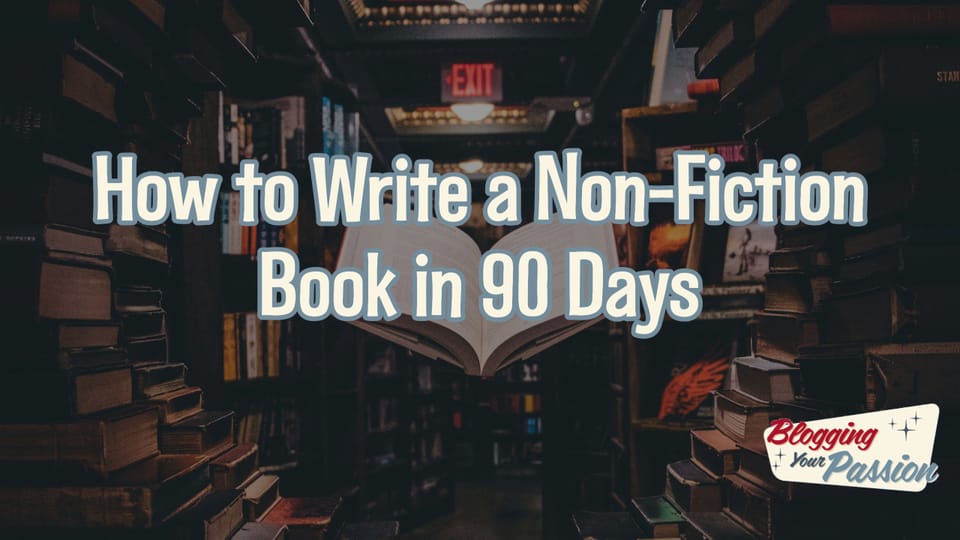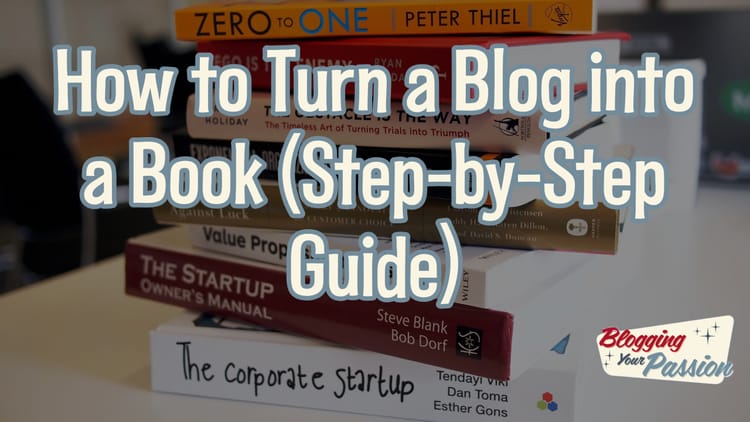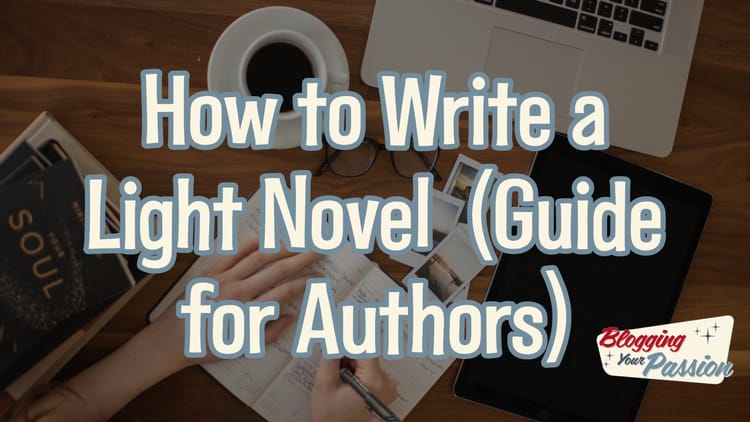How to Write a Non-Fiction Book in 90 Days (2024 Guide)

Looking to write a non-fiction book in just 90 days?
Well, you've come to the right place.
I'm here to guide you through the process step by step.
I teach an effective, simple book writing strategy called the compact book.
It's a shorter book (around 30,000 words) than a normal book (60,000 words).
Here's what's great about a compact book:
- It's lean, concise, and stripped of unnecessary fluff.
- It's a nugget of wisdom readers can consume in 2 to 3 hours, not 6 to 8.
- You can still offer it in all formats - Kindle, Paperback, Hardcover, even an Audiobook...
- And you can charge the same price as a normal-sized book!
Together, we'll tackle everything from crafting a compelling book outline to setting clear goals and deadlines.
With an effective writing routine and the help of AI for quotes and stories, you'll be amazed at how quickly your book takes shape.
So let's jump in and make your book-writing dreams a reality!
Table of Contents (click to expand)
- Step 1. Write a Shorter Book (30,000 words)
- Step 2. Craft a Compelling Book Outline
- Step 3. Set a Clear Goal and Deadline
- Step 4. Create an Effective Writing Routine
- Step 5. Use AI for Quotes and Stories
- Step 6. Research Your Topic Thoroughly
- Step 7. Organize Your Material
- Step 8. Write Rapid Drafts
- Step 9. Use the 20-Minute Sprint Method
- Step 10. Structure Your Book Strategically
- Step 11. Hire a Developmental Editor
- Step 12. Finalize Your Manuscript
Key Takeaways
- Clear book planning and organization is essential for completing a non-fiction book in 90 days.
- Utilize AI technology to generate quotes, stories, and writing prompts to enhance the book.
- Thorough research establishes credibility and adds depth to the book.
- Implement effective writing techniques such as rapid drafting and the 20-Minute Sprint Method to stay motivated and overcome writer's block.
Step 1. Write a Shorter Book (30,000 words)
Writing a shorter book can be a great option for non-fiction authors who want to complete their first book idea in just 90 days.
When you have a limited timeframe, it's important to have a clear book plan in place.
Start by brainstorming chapter topics that align with your main message. This will help you stay focused and organized throughout the writing process.
As you outline the structure of your book, consider the flow of information and how each chapter builds upon the previous one.
Once you have a solid outline, it's time to start writing. Remember, the goal is to keep the book concise and to the point.
During the editing process, make sure to eliminate any unnecessary content and refine your ideas.
Lastly, don't forget the importance of chapter titles. They should be engaging and reflect the essence of each chapter.
By following these steps and staying committed to your writing schedule, you can successfully complete a non-fiction book in just 90 days.
Step 2. Craft a Compelling Book Outline
Start by outlining your book to create a compelling structure that will engage your readers from beginning to end. Crafting a compelling book outline is the first step in the writing process for nonfiction books, especially self-help books.
It sets the roadmap for your book, guiding both you as the author and your readers through the content.
A well-crafted outline ensures that your book has a clear and organized structure, making it easier for your readers to follow along and understand your message.
When creating your book outline, consider the main topics and subtopics that you want to cover. Think about the key points you want to convey and the order in which they should be presented.
Your outline should flow logically, leading your readers from one idea to the next, building upon each other to create a cohesive narrative.
Incorporating a table of contents into your outline can also be beneficial. It gives readers a preview of what they can expect from your book and allows them to quickly navigate to the sections that interest them the most.
A well-structured outline with a clear table of contents can help your readers feel more connected to your book, as they can easily find the information they are seeking.
Crafting a compelling book outline is an essential part of the writing process for nonfiction books. It not only helps you stay organized and focused but also ensures that your readers will feel a sense of belonging as they embark on the journey through your book.
So take the time to create a solid outline, and you'll be well on your way to creating a book that engages and resonates with your audience.
Step 3. Set a Clear Goal and Deadline
To stay focused and motivated, you should establish a clear goal and a realistic deadline for completing your book.
Writing a non-fiction book in 90 days may seem like a daunting task, but with the right mindset and a well-structured plan, it is achievable.
Here are some key steps to help you set a clear goal and deadline:
- Define your purpose: Determine why you want to write this book and what you hope to achieve. This will provide you with a sense of direction and motivation throughout the process.
- Break it down: Divide your book into chapters or sections and set targets for completing each one. This will help you stay organized and make the writing process more manageable.
- Use keywords: Identify the main themes or keywords that you want to focus on in your book. This will help you stay on track and ensure that your content is cohesive.
- Enhance your writing skills: Take the time to improve your writing skills by reading books on nonfiction writing and practicing regularly. This will help you write more effectively and efficiently.
Step 4. Create an Effective Writing Routine
By establishing a consistent writing routine, you'll be able to make steady progress towards your goal of finishing your non-fiction book within the set timeframe. As nonfiction writers, we often draw from our personal experiences to bring our stories to life.
However, without a structured routine, it can be challenging to stay motivated and focused. That's why creating an effective writing routine is crucial.
To begin, start by setting aside dedicated time each day to work on your book. Whether it's an hour in the morning or a few hours in the evening, find a time that works best for you and stick to it.
This consistent schedule will help train your brain to be in writing mode during those specific hours.
Next, establish a comfortable and inspiring writing environment. Find a quiet space where you can focus and be free from distractions. Surround yourself with things that spark creativity, such as inspirational quotes or pictures related to your topic.
In addition to a set schedule and a conducive environment, it's also essential to break down your writing process into manageable tasks. Set small goals for yourself, like completing a chapter or reaching a specific word count each day.
By doing this, you'll be able to track your progress and stay motivated.
Lastly, remember that the first draft doesn't have to be perfect. Allow yourself to write freely without worrying about grammar or structure.
Once you have completed your first draft, you can always seek the help of a professional editor to refine your work.
Step 5. Use AI for Quotes and Stories
Are you struggling to find the perfect quotes and stories for your nonfiction book? AI can assist you in generating compelling and relevant content that will captivate your readers.
As an author embarking on the writing journey, I understand the importance of finding the right material to enhance my book. That's why I turned to AI for help.
One of the greatest challenges in writing a nonfiction book is the need for academic works and credible sources. AI can sift through vast online databases to find the most reputable quotes and stories to support your ideas.
It saves you time and ensures that your work is grounded in evidence (but always verify anything the AI produces).
Another advantage of using AI is its ability to provide writing prompts. Sometimes, we get stuck and need a little push to continue our creative flow.
AI can offer suggestions and inspire us to think outside the box. It's like having a writing partner who always has fresh ideas.
AI can provide honest feedback on your work. It can analyze your writing style, identify areas for improvement, and even suggest ways to make your content more engaging.
This feedback is invaluable in refining your book and making it more appealing to your target audience.
Step 6. Research Your Topic Thoroughly
Researching your topic thoroughly is essential for creating a well-informed and credible nonfiction book. As a nonfiction author, I understand the importance of delving deep into my subject matter to provide readers with accurate and valuable information.
Here are three reasons why thorough research is crucial for any nonfiction book:
- Building credibility: By conducting extensive research, you establish yourself as an authority on your chosen topic. This credibility will not only attract readers but also make them trust the information you present in your book.
- Uncovering case studies: Researching your topic thoroughly allows you to discover relevant case studies that support your ideas and provide real-life examples. These case studies add depth and authenticity to your book, making it more engaging and relatable for readers.
- Developing your book idea: Thorough research helps you refine and develop your initial book idea. It enables you to explore different angles, find unique perspectives, and uncover lesser-known facts. This in-depth understanding of your specific topic will make your book stand out and offer something new to readers.
Step 7. Organize Your Material
To effectively organize your material, start by outlining the main points you want to cover in your nonfiction book. This step is crucial in creating a clear and cohesive structure for your writing.
When outlining, consider the main points you want to convey to your readers. These points will serve as the foundation for your book, guiding the reader through your ideas and arguments.
One key aspect to consider is the chronological order of your main points. By organizing your material in a logical sequence, you can help your readers follow the narrative arc of your book.
This also allows for a smooth flow of information and ensures that your ideas are presented in a coherent manner.
Another important element to keep in mind is character development. Whether you're writing a memoir or a self-help book, developing your characters, including yourself, is essential.
This helps your readers connect with the story and provides a sense of belonging.
Lastly, don't forget to think about your book cover. While it may seem like a small detail, a well-designed cover can attract readers and make them feel a sense of belonging to your book.
Consider using images or colors that are relevant to your main points or that evoke emotions related to your topic.
Step 8. Write Rapid Drafts
Writing rapid drafts allows me to quickly capture my ideas and get them down on paper. It's a crucial step in my journey to write a non-fiction book in 90 days.
When I sit down to write, I don't worry about perfection or polished sentences. Instead, I focus on getting my thoughts out as quickly as possible.
Here are three reasons why writing rapid drafts is so important:
- Capture the Essence: Rapid drafts help me capture the essence of my ideas without getting caught up in minor details. By writing freely and without judgment, I can fully express my thoughts and ensure that no ideas are left behind.
- Build Momentum: Writing rapid drafts allows me to build momentum and maintain a consistent flow of ideas. It helps me overcome writer's block and keeps me motivated to continue writing.
- Refining the Book Title: Through rapid drafts, I can experiment with different book titles and see which one resonates the most with my end goal. It gives me the freedom to explore and refine the title until it perfectly captures the essence of my book.
As I approach the final stage of writing my book, I know that these rapid drafts will serve as the foundation for further development.
They provide me with a solid starting point and give me the confidence to bring my ideas to life in the most authentic and powerful way possible.
Step 9. Use the 20-Minute Sprint Method
When using the 20-Minute Sprint Method, you'll find that it's an effective way to boost your productivity and overcome any distractions that may arise.
It's a technique I discovered while struggling with writer's block during my journey of writing an academic nonfiction narrative.
As I stared at the blank page, feeling overwhelmed by the enormity of the task, I knew I needed a solution. That's when I stumbled upon the 20-Minute Sprint Method.
The concept is simple but powerful. Set a timer for 20 minutes and commit to writing without any interruptions. During this time, you focus solely on getting words on the page, without worrying about perfection or editing.
Once the timer goes off, take a short break before starting another sprint.
What makes this method so effective is its ability to create momentum. By breaking the writing process into manageable chunks, it becomes less daunting. Each sprint builds on the previous one, gradually filling the blank page with your ideas and thoughts.
And the best part?
It's a technique that can be applied to any form of writing, whether it's blogging, book writing, or personal journaling.
Step 10. Structure Your Book Strategically
If you structure your book strategically, you'll create a more engaging and cohesive reading experience for your audience. Planning the organization and flow of your nonfiction book is crucial to its success.
Here are five key elements to consider when structuring your book strategically:
- Clear Outline: Start by creating a detailed outline that outlines the main topics and subtopics of your book. This will serve as a roadmap for both you and your readers.
- Logical Progression: Arrange your chapters and sections in a logical order, ensuring that each topic builds upon the previous one. This will help your readers follow the flow of your ideas and stay engaged.
- Consistent Style: Maintain a consistent writing style throughout your book. This includes using consistent language, tone, and formatting. It will create a sense of cohesion and professionalism.
- Engaging Introductions: Grab your readers' attention from the start by writing compelling introductions for each chapter or section. This will entice them to keep reading and provide a sense of anticipation.
- Effective Transitions: Use transitional phrases and sentences to smoothly guide your readers from one topic to another. This will create a seamless reading experience and prevent any confusion or disconnection.
By structuring your nonfiction book strategically, you'll not only make it easier for your audience to follow along but also enhance their sense of belonging as they navigate through the chapters.
With careful planning and attention to detail, you can create a book that captivates and inspires your readers within the span of 90 days.
Step 11. Hire a Developmental Editor
Now that we've discussed how to structure your book strategically, let's move on to the next crucial step in creating a good nonfiction book: hiring a developmental editor.
As an aspiring author, you may wonder why hiring a developmental editor is the best way to go. Well, let me tell you, my fellow writers, a developmental editor is like the secret ingredient that takes your book from good to great.
They have the expertise to guide you through the entire writing process, ensuring your ideas are clear, your arguments are strong, and your overall narrative flows smoothly.
When it comes to finding the right developmental editor for your target audience, it's important to do your research. Look for professionals who specialize in your genre and have a track record of helping authors like yourself.
They can provide valuable insights and feedback to help you refine your ideas and make your book even more appealing to your readers.
Working with a developmental editor also allows you to bounce ideas off someone who understands the industry and can help you generate titles that will resonate with your target audience.
They can provide a fresh perspective on your work, helping you craft a compelling and engaging story that will captivate readers.
In summary, hiring a developmental editor is the best way to ensure you create a good nonfiction book.
Their expertise and guidance will help you refine your ideas, connect with your target audience, and ultimately create a book that you can be proud of.
Step 12. Finalize Your Manuscript
To finalize your manuscript, you need to meticulously review every chapter and ensure that your ideas flow seamlessly from one to the next.
This process is crucial in creating a book that captivates your readers and leaves them feeling a sense of belonging.
The easiest way to accomplish this is by reading your full text from start to finish, allowing yourself to immerse in the journey you've crafted. As you read, pay attention to the transitions between chapters, ensuring they are smooth and logical.
Look for any gaps in information or inconsistencies in your writing that need to be addressed.
Having a good editor can greatly assist in this finalization process. They can provide valuable feedback on the overall structure and flow of your manuscript. With their expertise, they can identify areas that may need more development or clarification.
A good editor will help you polish your work, ensuring that your ideas are presented in the most effective and cohesive manner possible.
Frequently Asked Questions
How can I overcome writer's block while writing my non-fiction book?
To overcome writer's block, I find inspiration in everyday experiences and engage in activities that stimulate my creativity. I also set realistic goals, establish a routine, and seek support from fellow writers.
How do I choose the best publishing option for my non-fiction book?
I choose the best publishing option for my non-fiction book by considering my goals, budget, and audience. I research traditional publishers, self-publishing platforms, and hybrid options to find the right fit for me.
What are some effective strategies for marketing and promoting my non-fiction book?
Some effective strategies for marketing and promoting my non-fiction book include building an online presence, utilizing social media platforms, offering free blog content, seeking endorsements, and engaging with my target audience through events and collaborations.
How can I ensure that my non-fiction book is engaging and keeps readers interested?
To keep readers engaged, I focus on providing valuable information, using relatable examples, and incorporating storytelling techniques. I strive to create a sense of connection and belonging by addressing their specific interests and concerns throughout the book.
Are there any legal considerations or copyright issues I should be aware of when writing a non-fiction book?
When writing a non-fiction book, it's important to be aware of legal considerations and copyright issues. This ensures that you are respecting the rights of others and avoiding any potential legal troubles in the future.
As a new nonfiction writer, how do I come up with a compelling topic and overarching theme for my book?
Consider an area of expertise or experience you can share, research online databases and best books lists for inspiration on generated titles and themes that are resonating with readers.
What's the best kind of non-fiction to write if I want to get published quickly?
Generally more personal stories and narratives of real people and true events stand the test of time. Find a unique personal story or angle within 90 days.
How do I structure my non-fiction book and identify the key plot points?
Identify the main idea first, then determine 3-5 key supporting themes. Outline 10-15 chapters to map to those themes as the key plot points before writing.
What is the definition of success for new nonfiction authors?
Finishing an entire quality book within 90 days is an accomplishment. Focus on writing well rather than well-known author fame.
How much research should I do?
While some academic writing requires a lot of research, aim for a great personal story with helpful resources to appeal to new writers. Lean on your own experiences.
Conclusion
Writing a non-fiction book in just 90 days may seem like a daunting task, but it can be accomplished with the right strategies and mindset.
First, focus on writing a shorter book. This will help you stay focused and avoid getting overwhelmed.
Craft a compelling outline that outlines the main points and structure of your book. This will serve as a roadmap for your writing process.
Set clear goals and deadlines for yourself. This will help you stay accountable and motivated throughout the writing process.
Create an effective writing routine that works for you. Whether it's writing for a set amount of time each day or setting word count goals, find a routine that helps you stay consistent.
Utilize AI for quotes and stories. This can save you time and provide valuable insights and information for your book.
Use the 20-Minute Sprint Method to boost your productivity. Set a timer for 20 minutes and write as much as you can during that time. Take short breaks in between sprints to keep your energy levels up.
Structure your book strategically. Organize your chapters and sections in a logical and coherent way that will make it easier for readers to follow along.
Consider hiring a developmental editor. They can provide valuable feedback and help you refine your manuscript.
Remember, with dedication and perseverance, you can bring your ideas to life and share your knowledge with the world.





